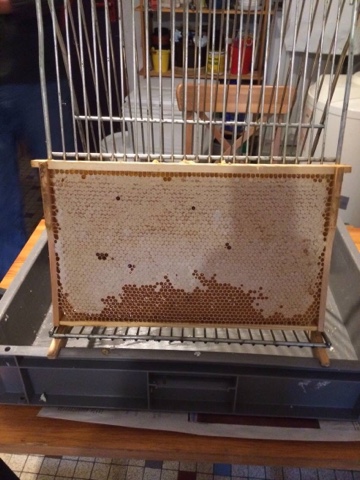This morning we went over and took off the honey super and the escape board. The method worked well, and there were very few bees in the super. We gently brushed people off into the hive. Then we moved the super to the car. It was very heavy. This is why some beekeepers prefer half-size honey supers.
Later we learned that the super (with the frames and honeycomb) weighed about 23 kg (about 50 lbs).
I took it to my friend's house. He has two extractors. The one in the back of the photo below is electric, but, sadly, my frames don't fit in it (too small). So we used the hand-crank one in the foreground. It could hold two frames at a time.
But first we had to cut the caps on the wax cells. I did this with a special fork. After you uncap both sides of the frame, you can put the frame in the extractor and give it a spin.
Uncapped frames look like this.
Here you can see me uncapping the wax with the fork.
The honey comes out a valve in the bottom of the extractor and into a special bucket with a valve. I have a plastic one, but it leaks a little. I can see that it might be a good idea to use a stainless steel container (#ChristmasWishList).
When I got the honey home, I weighed it. I forgot to weigh the empty bucket, but together they are a little over 19 kg (just under 42 lbs).
Later this week I will dispense the honey into jars. Many beekeepers in Luxembourg like to whip their honey to prevent it from crystallizing. But this creates spreadable and not runny honey. I may take my chances, although this honey has a rather low water content (about 15%), which, as I understand it, is good, but might lend itself to crystallizing sooner.



Very interesting! I have a question - is the first photo of the frames before you uncapped them? I assume the white part is the cap but perhaps I'm missing something.
ReplyDeleteI thought America's Test Kitchen told me that you can "de-crystallize" the honey with a warm water bath. If that is the case, couldn't you leave it as is and then do that if you see any crystallizing later?